Employee Advocacy Statistics
Earning organic reach on social media is increasingly difficult as content volume increases and social algorithms favor individual content over branded content.
Therefore, employee advocacy is one of the best ways to authentically promote your brand to your ideal target audience across social media platforms. To prove this point, we conducted original research and surveyed 100 social media marketing professionals who currently manage a formal employee advocacy program.
Here are our research results and a curated list of the most relevant employee advocacy statistics that show how employee advocates can improve your overall marketing strategy.
Employee Advocacy Statistics (New Data From GaggleAMP)
What are the main benefits of employee advocacy?
Survey results show the top three benefits of employee advocacy are attracting top talent, increasing brand awareness, and improving employee engagement and loyalty. Here’s a full breakdown of the survey results:
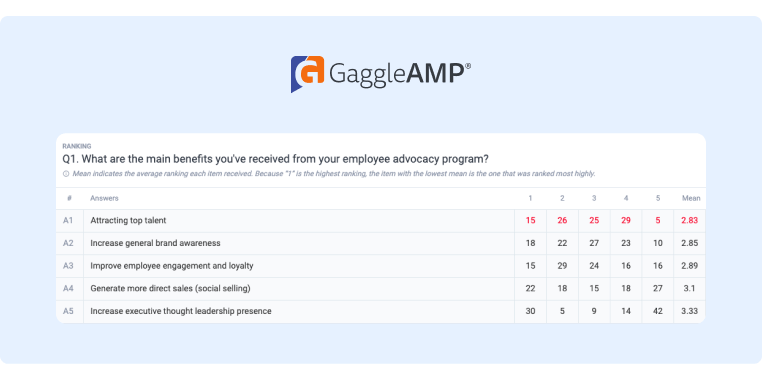
How effective is employee advocacy?
Employee advocacy is very effective, with 73% of social media managers reporting that employee advocacy doubles the brand's social media engagement and 26% report that it triples the brand's social media engagement.
Here's a full breakdown of the statistics:
- 13% report that employee advocacy increases branded social media engagement by 150-200%.
- 44% report that employee advocacy increases branded social media engagement by 201-250%.
- 23% report that employee advocacy increases branded social media engagement by 251-300%.
- 5% report that employee advocacy increases branded social media engagement by more than 300%.
How do you implement an employee advocacy program?
Social media managers report:
- 73% use employee advocacy platforms to implement their employee advocacy programs.
- 59% use Slack to send employee engagement requests.
- 42% use email to send employee engagement requests.
How much time do social media managers spend on employee advocacy programs?
59% of social media managers spend three to six hours per week on employee advocacy.
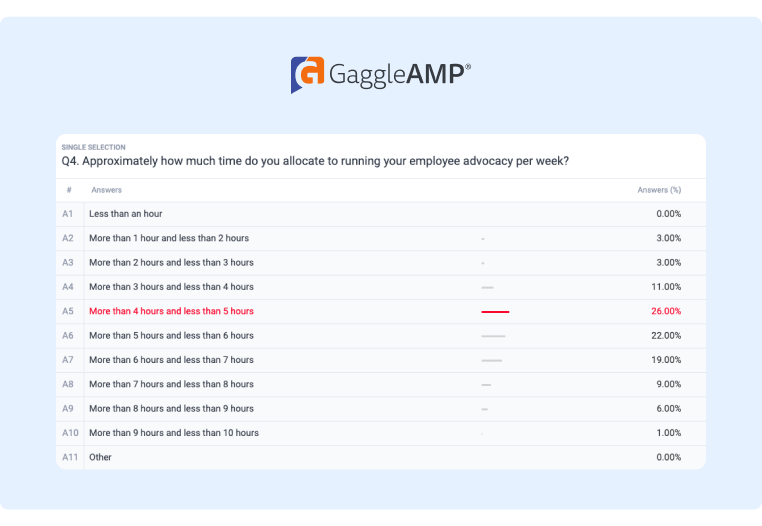
How do you measure employee advocacy?
Most social media managers measure the effectiveness of employee advocacy by total sales resulting from employee advocacy efforts (74%), estimated earned media value (71%), and total post engagement (54%).
90% of the social media managers surveyed track employee advocacy and here’s a full breakdown of the most common KPIs used:
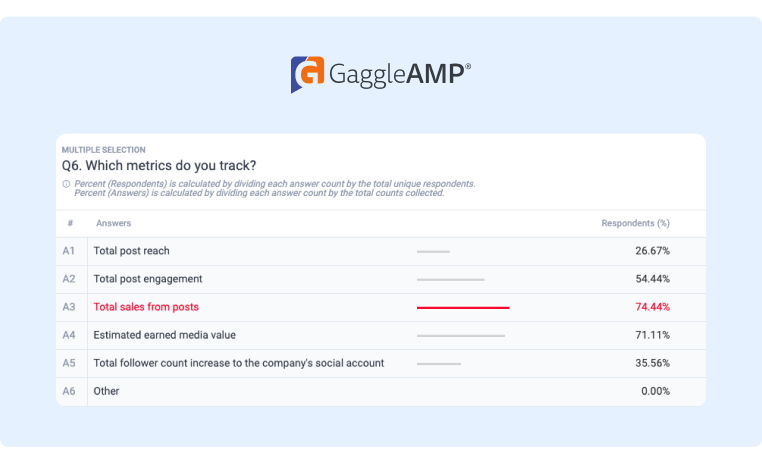
How many social media managers track employee engagement?
86% of social media managers track employee advocacy engagement.
What percentage of employees respond to employee advocacy requests and engage with branded content on social media?
74% social media managers report that their employees respond to at least half of engagement requests.
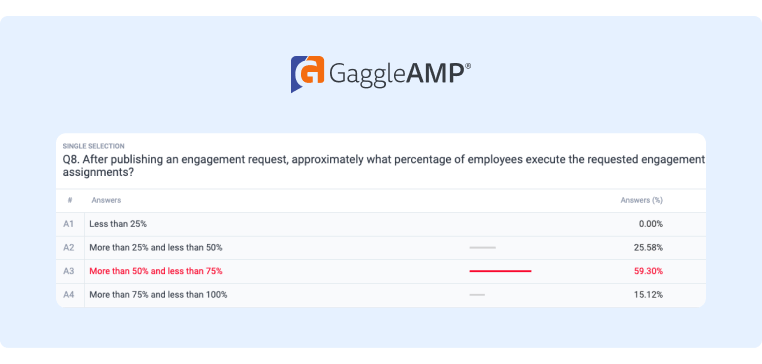
What are the biggest challenges of employee advocacy?
74% of social media managers cited their top challenge is getting employees to engage and actively participate in employee advocacy. Their second biggest challenge is achieving executive buy-in.
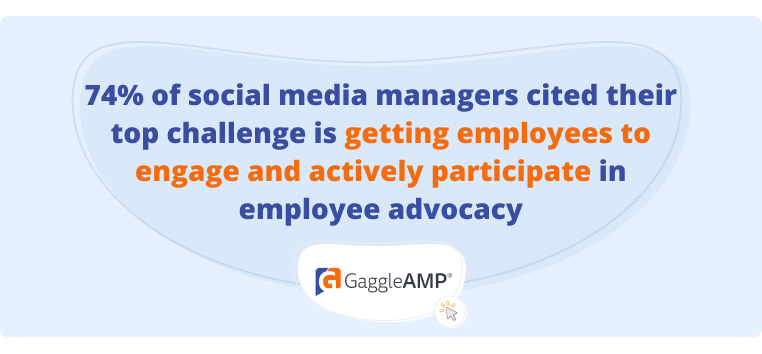
Here's a full breakdown of the most common challenges of employee advocacy as reported by social media managers:
- 74% getting employees engaged.
- 58% achieving buy-in from executives.
- 41% measuring the ROI of employee advocacy.
- 37% finding tools to efficiently send engagement requests.
How many employees post about brand initiatives on their personal social media accounts?
78% of social media managers report that more than 50% of their employees post brand messages on their personal social media accounts regularly (at least once every two months).
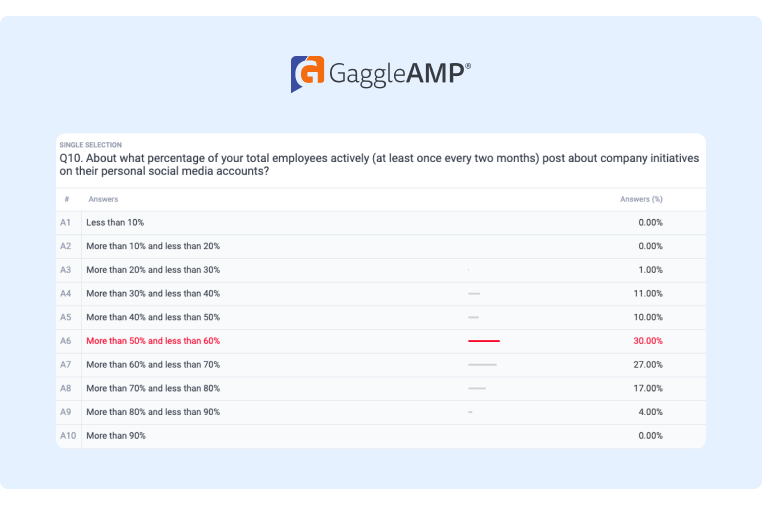
How many employees engage with branded social media content from their personal social media accounts?
73% of social media managers report that more than 50% of their employees regularly engage with branded social media content (at least once every two months).
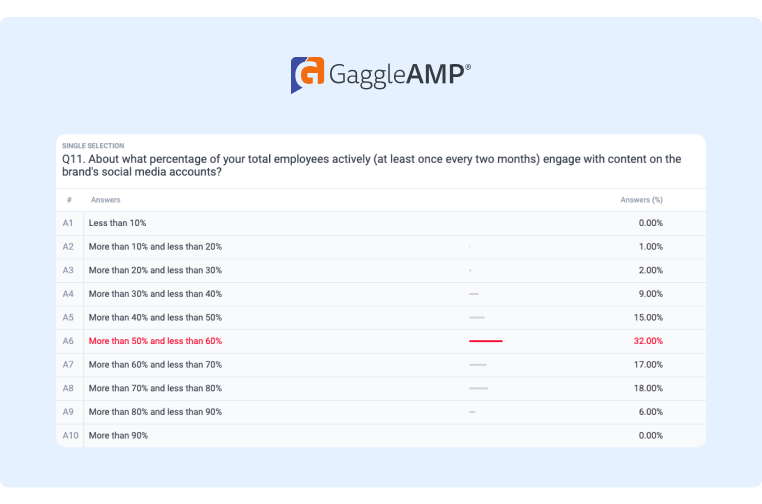
How effective is employee advocacy at driving brand awareness?
74% of social media managers report that employee advocacy is somewhat or very effective at driving brand awareness. 3% report employee advocacy is ineffective at driving brand awareness.
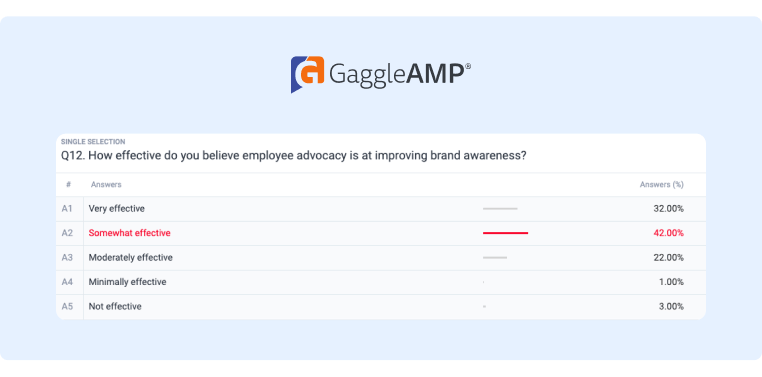
How often do social media managers engage with brand content?
78% of social media managers engage with company content or post about company initiatives daily or weekly.
We hope this new research provided by GaggleAMP gives you some baseline metrics you can use to measure the effectiveness of your existing employee advocacy program. Below, we’ll provide some additional statistics that you can use to further improve your employee advocacy program.
Statistics on the Impact of Employee Advocacy
Do the employees benefit from employee advocacy programs?
Yes. In a Hinge Marketing study, employees received the following benefits from their employee advocacy program:
- 87% expanded their professional network.
- 76% used it to keep up with industry trends.
- 48% accessed opportunities for professional partnerships.
- 47% developed high-demand skills.
- 44% were recognized as thought leaders in their industry.
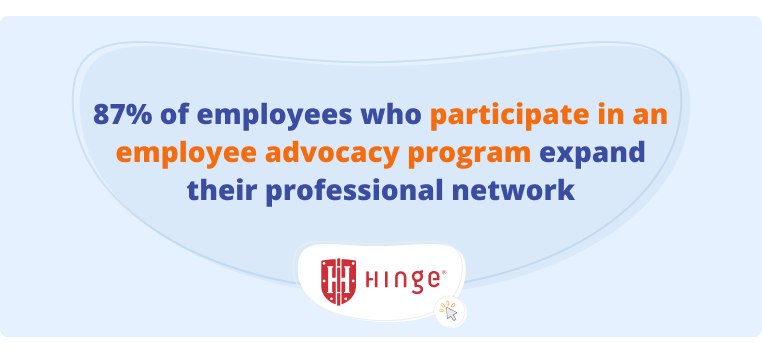
What are the benefits of employee advocacy for the organization?
Hinge Marketing’s study shows 71% of firms experienced increased visibility, and 65% experienced increased brand recognition as a benefit of introducing an employee advocacy program. The following are measurable benefits that 96% of firms reported from introducing an employee advocacy program:
- 44.9% increased inbound traffic.
- 32.4% increased search engine rankings.
- 24.6% increased content downloads.
- 17% decreased marketing costs.
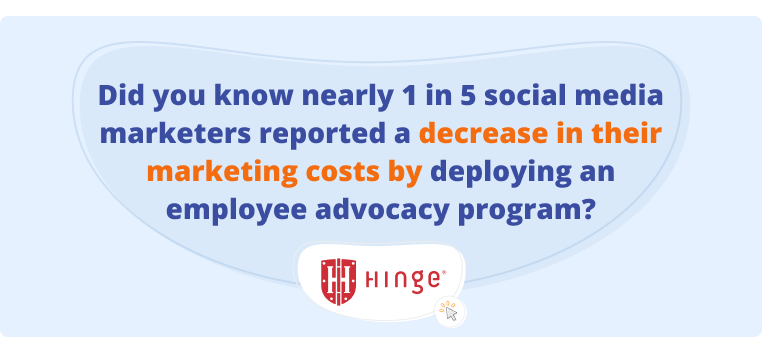
B2B Social Media Statistics
What percentage of employees use social media at work?
- 77% of employees use social media at work.
- 58.8% of employees in a formal employee advocacy program spent five hours weekly on business-related social media activities.
Which social media networking site is preferred in the B2B segment?
- LinkedIn was ranked as the top platform for B2B lead generation.
- 40% of B2B marketers indicated that LinkedIn is the most effective channel for driving high-quality leads.
- Audiences exposed to brand and acquisition messages on LinkedIn are 6x more likely to convert.
What percentage of B2B buyers use social media to make purchasing decisions?
- 59% of decision-makers agree that an organization's thought leadership content is a more trustworthy basis for assessing its capabilities than the company's content marketing.
Does employee advocacy boost social media engagement?
Yes. LinkedIn’s study showed that content has 2x higher engagement when shared by employees.
Does employee advocacy boost employee loyalty?
Yes. According to research by Hootsuite, employees who viewed posts about their colleagues and company felt a stronger connection to the organization.
How do you encourage employees to engage on social media?
Some ways to encourage employees to engage on social media include making tasks easier by providing pre-written content, giving social media training, and communicating your brand’s social media goals. Here’s why you should implement these tips:
- 72% of employees would post about their company if the content was written for them.
- 57% of respondents said additional training on social media engagement would significantly impact employees in their firm.
- 41% of respondents said that communicating the importance of social media was the biggest incentive for employees to become brand advocates.
Employee Advocacy and Recruitment Statistics
How does employee advocacy affect talent acquisition and retention?
According to research by GaggleAMP, attracting top talent is the most significant benefit of employee advocacy. LinkedIn research further supports that finding, reporting job openings shared by employees yield 30% more applicants.
Why is employer branding important for recruiting?
Here are a few recruitment statistics that reflect the importance of developing a strong employer brand:
- 75% of active job seekers are likely to apply for a job if the employer actively manages its employer brand.
- A strong employer brand can reduce the cost per hire by as much as 50%, and a negative reputation can cost a company as much as 10% more per hire.
- An employee’s voice is 3x more credible than the CEO's voice when talking about working conditions in that company.
Employee Advocacy and Sales Statistics
Can social media improve customer acquisition?
Yes, social media can improve customer acquisition. The following statistics show:
- 92% of B2B buyers engage with sales professionals if they are known industry thought leaders.
- 78% of respondents report that social media empowered them to reach prospective customers more efficiently than other media.
What percentage of decision-makers say that thought leadership can be effective in influencing their purchase decisions?
A thought leadership study by Edelman and LinkedIn reported:
- 47% of decision-makers thought leadership can effectively influence their purchasing decisions.
- 67% prefer thought leadership to prominently feature the point of view of an identifiable author instead of being published by a faceless brand.
How many times more likely is it for a potential customer to convert when developed through employee social marketing?
According to IBM, leads developed through employee-shared messages are 7x more likely to convert.
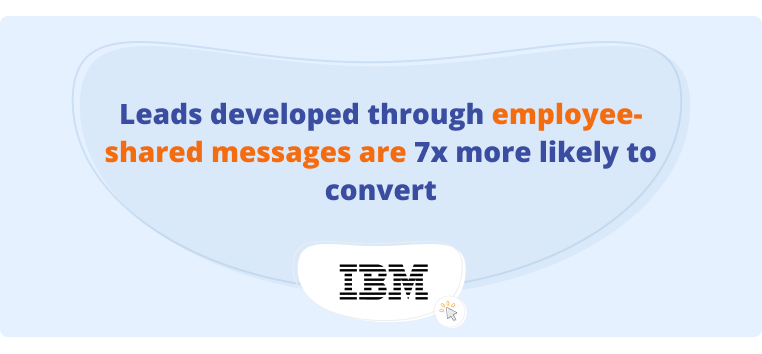
Start Your Employee Advocacy Program Today
By now, it should be obvious that employee advocacy can positively impact brand awareness, sales, marketing, and recruiting efforts.
However, convincing your marketing and sales teams to share content across various social channels is challenging. So to help you implement a successful employee advocacy program, consider using an employee advocacy tool like GaggleAMP.
GaggleAMP makes it easy for social media managers to assign individual content to employees at scale, which saves you time and increases employee engagement rates. GaggleAMP Members enjoy being more active on social media, forming new relationships with peers online, and even gamifying their experience with the GaggleAMP leaderboard.
To see for yourself how GaggleAMP can positively impact your objectives and key results (OKRs), schedule a demo today!

